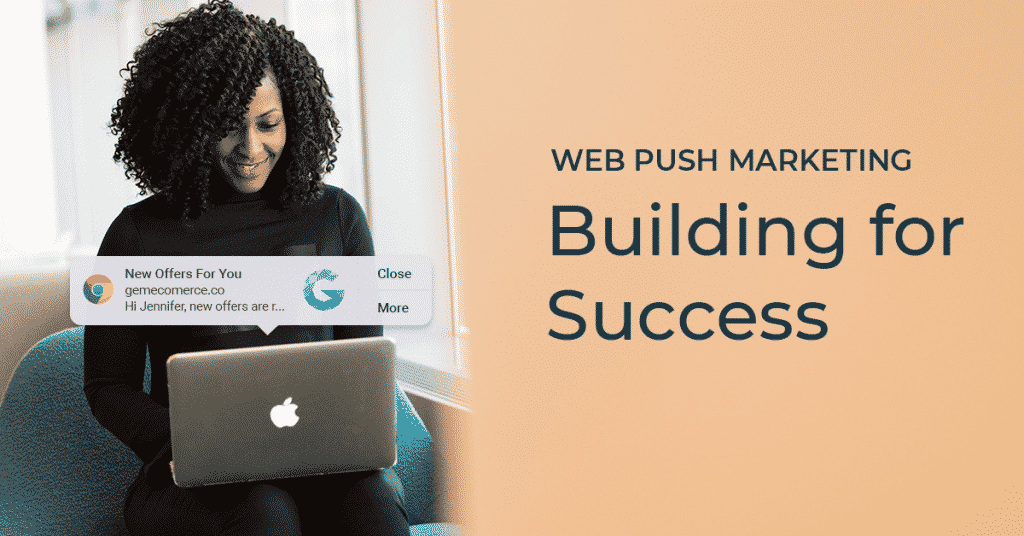It all started with Apple in 2009, creating Push Notifications to enable App developers a way to re-engage with their users. Apple then rolled out Push Notification support within Safari in 2013, which allowed web browsers to ask users for permission to send them a Web Push Notification. Web Push Notifications were so well received that Chrome added the support for them within that first year.
With the rollout of Web Push Notifications across browsers, brands began to really explore this channel. Previously, a web user would need to engage via a form, in-web message or online chat to provide them with valuable information and gain some engagement. With the addition of Web Push Notifications, brands could easily request permission from their web users to enable them to send out a message directly to the users within the browser, even when they were not on the brand’s website. Powerful stuff!
Benefits of Web Push Notifications
Web Push Notifications have plenty of benefits for enterprises who implement them including:
- Easy to implement
- All brands need is a website and they can implement a Web Push Notification strategy
- All brands need is a website and they can implement a Web Push Notification strategy
- Simple for the user to subscribe
- Ask the user when they are on site and simple one button subscription process.
- No mobile app required
- Push Notifications aren’t just for brands that have a mobile app
- Subscribers don’t need to be on site to receive notification
- Engage with users when they are on different sites, or to re-engage users who have not visited in a while
- Provides high engagement opportunities
- Enables brands to help users find what they are looking for or to travel further down the sales funnel
- Excellent for Customer Retention
- They work on Smartphones and tablets too
- Brands with a higher percentage of mobile web users can still benefit as Web Push Notifications work on smartphones and tablets too
- Rich Notifications
- Brands are not limited to just text, rich notifications enable imagery to be included too
- They are hard to ignore
- Users get a notification on their screen accompanied by an alert sound. (if they have the sound turned)
- Can be delivered at the right time
- Triggered by the behaviour of the user
- Targeted through segmentation
- Deliver the right message to the right users based on preference or behaviour
- Reduce shopping cart abandonment
- 67.45% of online shopping carts are abandoned before the customer completes the sale. (source) Alert active users of left items in the basket when they are searching a different site
How Web Push Notifications differ from Push Notifications
As previously mentioned within this post, first came the App Push Notifications back in 2009. The main difference between the two is that for standard Push Notifications to be delivered, the brand needs to have a mobile App, whereas, with a Web Push Notification, only a website is required.
Plenty of brands have seen the need within their industry to invest in building and maintaining a mobile App for their users to engage with. However, not all brands can invest in a Mobile App, especially as the average cost for a full business app is in excess of $120,000, and that is without maintenance costs. (source)
Web Push Notifications should not be treated as a substitute to Push Notifications either. While they inevitably have a large cross-over, many brands are able to utilize them in different ways and increase engagement opportunities across channels.
Implementing Web Push Notifications
Brands that understand how their users interact and engage with their website will be in a better position to implement Web Push Notifications into their overall engagement strategy. Understanding the user’s journey will provide more insight into where and how Web Push Notifications can be rolled out and what the expected results for them will be.
Are there particular products or services being viewed more often by users? Has shopping cart abandonment increased? Are users dropping off a particular customer journey on the website?
Using analytics, on a granular level to individual users, brands can create a more tailored and personalised journey for the user and maximise engagement opportunities. Additionally, these insights will allow brands to react to events that are occurring on their website, including shopping cart abandonment, browser abandonment, multiple product views without adding to basket etc. Once understood, then each of these events can be targeted with a highly personalised Web Push Notification campaigns to counteract the event. Discover more about implementing a basket abandonment programme in our recent post.
Using these engagement opportunities, a brand can help to influence the user into travelling further down the sales funnel by suggesting content, products or offers in real-time to magnify the chance of the sales completing. It is well documented that personalised marketing content can increase open rates by four-times that of non-personalised content (source), which gives enterprise brands even more reason to incorporate personalised Web Push Notifications into their marketing arsenal.
Finding the Right Solutions
Xtremepush has the solution enterprise brands need to fulfill their multi-channel marketing experience and engagement needs. Just like Jobbio, who partnered with Xtremepush to deliver highly intelligent, personalised multi-channel engagement. Their multi-channel marketing included Web Push Campaigns that increased engagement by over 17.5%. Discover how Xtremepush and Jobbio achieved this in our Case Study.
If you’d like to learn more about push notifications then we recommend checking our in-depth guide. It covers everything from set-up to best practices and use cases.
If your brand is looking to incorporate Web Push Notifications, speak to Xtremepush and begin to understand, engage and influence your customers.
